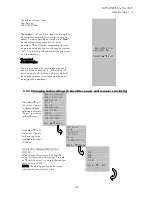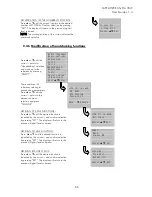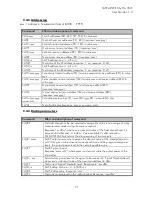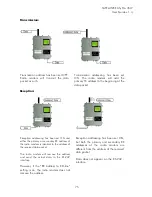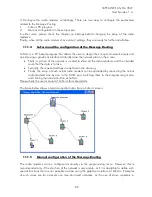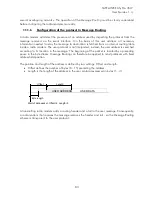
SATELLINE-EASy Pro 35W
User Guide v.1.4
69
9.3.11
Saving modified values into the internal memory
After all desired modifications have been performed; they have to be saved in order to make them
permanent (until next modification). This is accomplished by choosing selection ”EXIT” from the
main menu. The display will then show a message (see below) asking a confirmation of the
performed modifications.
By choosing ”YES” all modifications are saved into the non-volatile memory inside the radio
modem. By choosing ”NO” all modification performed are cancelled and previous settings
remaining in the non-volatile memory.
Press ”YES” to save all
modifications into the non-
volatile memory and ”NO”,
if modifications are to be
cancelled.
Save changes?
No
▼
YES
9.4
Changing parameters using the SL-commands
The controlling terminal device can change the configuration settings of a radio modem. This is
accomplished with the help of SL-commands, which can be used in data transfer mode. SL-
commands can be used to change e.g. the frequency or addresses. It is also possible to
interrogate a radio modem in order to gain information concerning current settings that are in
use. The terminal device is either a PC or a programmable logic (PLC) together with suitable
(terminal) program. SL-commands must be enabled using
Programming Mode
before they can be
used.
An SL-command is a continuous string of characters, which is separated from other data by
pauses that are equal or greater than time defined by Pause length parameter in the set-up. No
extra characters are allowed at the end of an SL-command. Serial interface settings are the same
as in data transfer and MODE pin of the serial connector MUST NOT be connected to ground
(GND). SL-command is properly recognised also in the case when the command string is
terminated in <CR> (=ASCII character no. 13, Carriage Return, 0x0d) or <CR><LF> (<LF>
= ASCII char. no. 10, Line Feed, 0x0a). If multiple SL commands are sent to the radio modem
the next command can be given after receiving the response ("Ok" or "Error") of the proceeding
command. In addition, it is recommended to implement a timeout to the terminal software for
recovering the case when no response is received from the radio modem.
When the power of a radio modem is switched off the configuration settings of a radio modem
always return to values defined initially using the
Programming Mode
, thus resetting any settings
changed using SL-commands during power on. It is however possible to save settings changed by
using SL-commands and to make them the new configuration settings.
The radio modem will acknowledge all commands by returning an "OK" (command carried out or
accepted) or the requested value, or an "ERROR" (command not carried out or interpreted as
erroneous) message.








